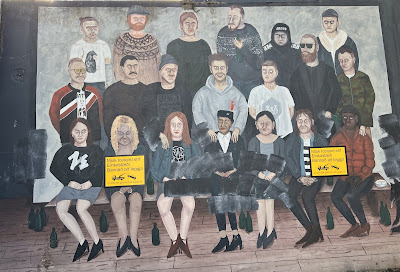 |
| Sculpture of Hrafna-Floki Vilgeroarson |
Floki Vilgeroarson was the first Norseman to deliberately visit Iceland. (The word "deliberately" is always used in reference to Floki to distinguish him from the other hapless sailors who inadvertently stumbled upon Iceland's shores.) His journey began in West Norway; he traveled from there to the Shetland Islands and then on to the Faroe Islands. The story goes that Floki had three ravens aboard to help him navigate from there to what became Iceland. When he thought he was approaching land, he released the first of the ravens. The bird was not interested in exploring new environs and headed back to the Faroe Islands. The second raven checked out where they were and came back to the ship, happy to roost in relative comfort. The third raven flew all the way to Iceland, and Floki used the bird as his compass. The pioneer thereafter became known as "Hrafna-Floki," which translates into "Raven Floki." As you can see, he is depicted in this sculpture with his raven.
 |
| "Sun Voyager" by Jon Gunnar Arnason (1990) |
You, like me, might expect that Arnason has depicted the bones of a Viking ship. But that's not the case. Arnason envisioned the sculpture as a dream boat and an ode to the sun, symbolizing light and hope and discoveries. What a beautiful tribute to this city.
 |
| Mural of Reykjavik street artists |
Thanks to some quick sleuthing by my friend Sheryl, I learned that this mural depicts some of the street artists responsible for the murals in Reykjavik. The city has a vibrant graffiti and street art culture that we only scratched the surface of in our wanderings. Just another thing to add to the list for my next visit. For more images of Reykjavik murals, click here and here.
 |
| "Fish Processing" by Gunnlaugur Scheving (1944) |
On their face, Scheving's figurative paintings might not seem radical. And yet in a sense they were. When Scheving began his career in the 1930s, Icelandic artists primarily painted landscapes. And why wouldn't they when the surrounding environment defined their lives in so many ways? But Scheving wanted to capture the men -- and women -- who worked in the fishing industry. It was, after all, the lifeblood of the country. And Scheving himself had worked in the industry during summer breaks from school. Scheving's paintings -- and the works of other artists working in a similar style -- were both a reminder of the hard work of these people and a pleasure to view.
 |
| "Women Fish Workers" by Hildur Hakonardottir (1971) |
While I wasn't able to find out anything specific about the work shown here, it clearly highlights the historic importance of women to the fishing industry. I'm sure the work was (and is) messy and stinky and not a lot of fun. At least the women had each other to help pass the time. And then there's the man looking down on the workers. Is he keeping an eye on them through a window or is it just a picture to remind them that he's lurking? In any case, there's a definite Big Brother vibe.
Sadly, we just missed a solo exhibition of Hildur's work at the Reykjavik Art Museum. Her work is pretty fabulous. To see some images from the exhibit, click here.
And so concludes the saga of my trip to Iceland. Yes, I loved it. And yes, I want to go back. But for now I'll just continue to reflect on the beauty of the country, its astonishingly clean environment and the friendliness of the people (which I've neglected to mention). It's a special place I wish everyone had the chance to experience -- and that I hope I'll have the chance to visit again.
.jpg)


No comments:
Post a Comment